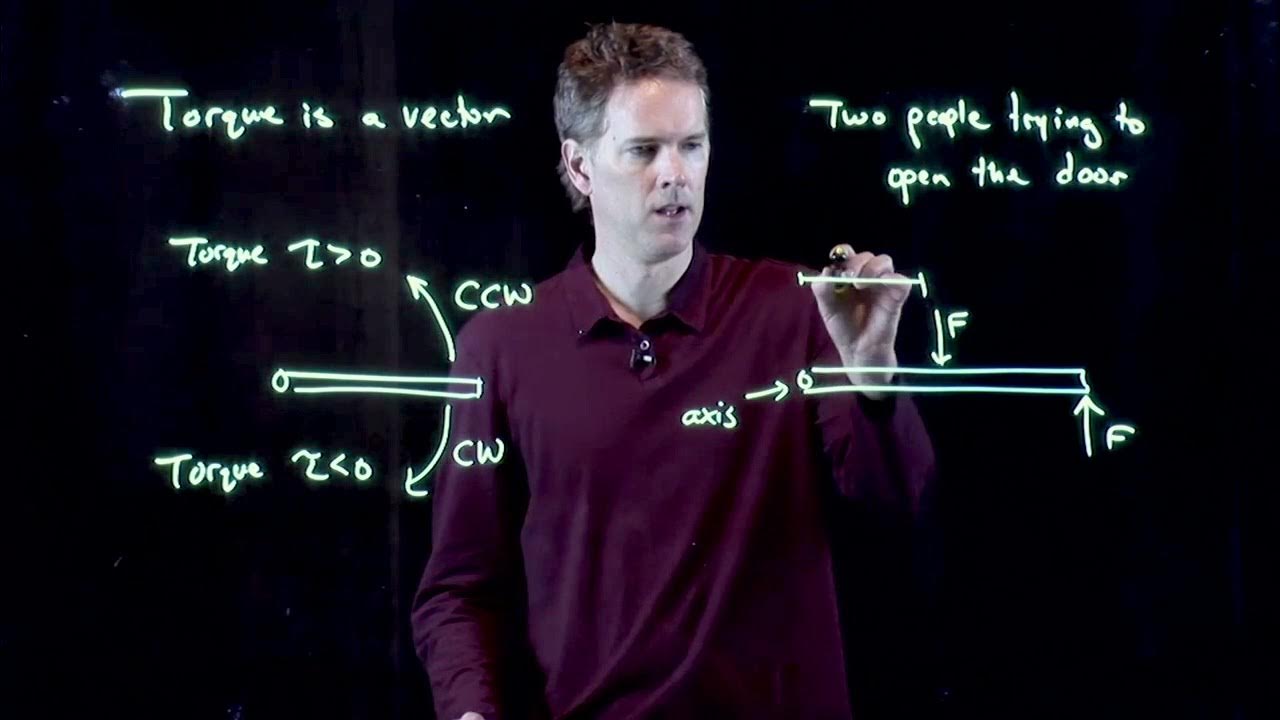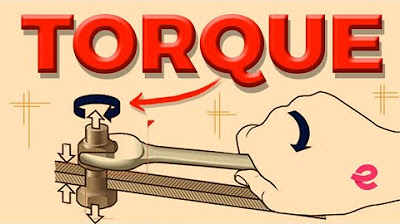Torque as a Cross Product | Physics with Professor Matt Anderson | M12-08
TLDRProfessor Anderson introduces the concept of torque and the cross product, explaining its application through the example of opening a door. He defines torque as a product of displacement, force, and the sine of the angle between them, emphasizing the use of the right-hand rule to determine direction. He further connects this principle to the tightening and loosening of bolts and screws, explaining how right-handed and left-handed threads impact bicycle mechanics. The discussion provides a comprehensive understanding of torque in physics and everyday applications.
Takeaways
- 📚 Introducing the concept of torque and cross product in physics discussions.
- 🚪 Using a door as an example to explain the application of force and the resulting torque.
- 📐 Defining torque as the cross product of the displacement vector (r) and the force vector (f).
- 🔢 Calculating torque involves multiplying the magnitudes of r and f with the sine of the angle between them.
- ➡️ The direction of torque is perpendicular to both r and f, determined by the right-hand rule.
- 🤚 Demonstrating the right-hand rule by aligning fingers with the direction of r and curling them towards f, with the thumb pointing in the direction of torque.
- 🔩 Relating the concept of torque to the common saying 'righty tighty, lefty loosey' for tightening and loosening screws.
- 🔩 Explaining that turning a screw to the right causes it to tighten (go into the material), while turning to the left loosens it.
- 🔧 Discussing the orientation of threads on bolts, with most being right-handed, following the 'righty tighty, lefty loosey' rule.
- 🚴♂️ Identifying a real-world example of a left-handed thread on a bicycle's right pedal, which tightens when pedaled forward.
- 🔩 Understanding the practical application of left-handed threads to prevent loosening under normal use, such as on a bicycle pedal.
Q & A
What is the significance of the cross product in the context of torque?
-The cross product is crucial in calculating torque because it determines the magnitude and direction of the torque. It involves multiplying the magnitudes of the displacement vector (r) and the force vector (F), and the sine of the angle between them. This calculation helps understand how effectively a force can cause rotation around an axis.
How do you apply the right-hand rule to determine the direction of torque?
-To use the right-hand rule, extend your right hand's fingers in the direction of the displacement vector (r), then curl them toward the force vector (F). Your thumb will then point in the direction of the torque, indicating whether the torque is directed into or out of the surface (in this context, the glass).
Why is it important to apply force perpendicular to the door when opening it?
-Applying force perpendicular to the door maximizes the torque exerted on the door, making it easier to open. This is because the sine of 90 degrees (the angle between the force and the displacement vector when force is applied perpendicularly) is 1, which maximizes the product of the magnitudes in the torque equation.
What does the phrase 'righty tighty, lefty loosey' refer to?
-This phrase is a mnemonic that helps remember the direction to turn most common screws and bolts to tighten or loosen them. 'Righty tighty' means turning clockwise to tighten, while 'lefty loosey' means turning counterclockwise to loosen.
Why are most bolts right-handed?
-Most bolts are right-handed because it conforms to the natural direction of tightening (clockwise) that is intuitively used by most people. This standardization simplifies manufacturing and usage, making it more efficient to produce and easier for people to work with.
Where can you commonly find a left-handed bolt, and why is it used?
-A left-handed bolt is commonly found on the left pedal of a bicycle. It is used there to prevent the pedal from loosening as the bike is pedaled forward. The counterclockwise motion of pedaling tightens the left-handed bolt, keeping the pedal secure.
What is the role of the angle phi in the torque equation?
-The angle phi represents the angle between the displacement vector (r) and the force vector (F) in the torque equation. It determines the effectiveness of the force in producing rotational motion about an axis, with torque being maximized when the angle is 90 degrees.
How does the cross product relate to both the magnitude and direction of torque?
-The cross product determines torque by multiplying the magnitudes of r and F and the sine of their angle, providing the magnitude of torque. The direction, as determined by the right-hand rule, is perpendicular to both r and F, defining the axis of rotation.
Can you explain the significance of 'n hat' (n̂) in the cross product formula for torque?
-'n hat' (n̂) in the torque formula represents the unit vector direction of the torque, which is perpendicular to the plane formed by the displacement vector (r) and the force vector (F). This directional aspect of torque helps in understanding how the force causes rotational movement about the pivot point.
Why is it advised not to use the left hand for the right-hand rule?
-The right-hand rule is designed based on the orientation and natural mechanics of the right hand to determine vector directions in cross products accurately. Using the left hand would reverse the direction, leading to incorrect interpretations of vector directions like torque.
Outlines
📐 Introduction to Torque and Cross Product
Professor Anderson begins the discussion by introducing the concept of torque and the cross product. He uses the example of opening a door with a force applied at a certain angle to the door. The torque exerted on the door is determined by the cross product of the displacement vector (r) from the axis of rotation to the end of the door, and the force vector (f) applied at the end of the door. The magnitude of the torque is the product of the magnitudes of r and f, multiplied by the sine of the angle (phi) between them. The direction of the torque is perpendicular to both r and f, and can be determined using the right-hand rule, which states that if you point the fingers of your right hand in the direction of r and curl them towards the direction of f, your thumb will point in the direction of the torque. In the case of the door, the torque is out of the glass.
⚙️ Torque and the Right-Hand Rule with Bolts
The second paragraph delves into the application of the cross product and the right-hand rule in the context of a bolt. Professor Anderson discusses the common saying 'righty tighty, lefty loosey', which describes the direction one must turn a screw or bolt to tighten or loosen it. This is related to the direction of the torque. Using the right-hand rule, if you point your fingers in the direction of the radius (r) of the bolt and curl them towards the direction of the force (f) applied by the screwdriver, your thumb will point in the direction the bolt will move. The professor explains that most bolts are 'right-handed', meaning they follow the 'righty tighty, lefty loosey' rule, with only a small percentage being 'left-handed' and following the opposite rule. The right-handedness of a bolt is likened to the threads on a gear and is a standard in most hardware, except for specific applications.
🚴♂️ Left-Handed Threads on Bicycle Pedals
In the final paragraph, Professor Anderson explores an example of where left-handed threads are intentionally used: on bicycle pedals. While most of the threads on a bike are right-handed, the threads on one of the pedals are left-handed to prevent the pedal from loosening as the cyclist pedals forward. When you pedal forward, the left-handed thread causes the pedal to tighten, ensuring it does not fall off. Conversely, the other pedal has right-handed threads. The professor also mentions that if you were to pedal in reverse for an extended period, the left-handed pedal might come loose, illustrating the importance of the thread direction in function. The unique use of left-handed threads on the bike serves as a practical application of the right-hand rule and torque concepts discussed earlier.
Mindmap
Keywords
💡Torque
💡Cross product
💡Displacement vector
💡Right hand rule
💡Magnitude
💡Angle phi (φ)
💡Direction of torque
💡Righty tighty, lefty loosey
💡Pedal threads
💡Helix pattern
Highlights
Introduction to torque and the concept of the cross product in relation to opening a door with a force.
Explanation of torque calculation involving the length of the door (r), the force applied (F), and the angle between them.
Definition of the cross product as the magnitude of r times the magnitude of F times the sine of the angle between them.
Description of the direction of torque using the right-hand rule to determine if it's into or out of the glass.
Demonstration of the right-hand rule with an audience to determine the direction of torque in a practical scenario.
Practical application of torque concept in tightening or loosening a Phillips head screw, known as 'righty tighty, lefty loosey'.
Illustration of how the direction of force applied to a bolt affects whether it tightens or loosens using the right-hand rule.
Differentiation between right-handed and left-handed threads on bolts and their respective tightening rules.
Statistical note that approximately 99% of all bolts are right-handed, with left-handed bolts being less common.
Mention of specific instances where left-handed threads are used, such as in the motor of a garage door opener.
Discovery of a left-handed bolt on a bicycle, specifically on the right pedal crank.
Explanation of why the right pedal on a bicycle has left-handed threads to prevent it from loosening as the bicycle is used.
Discussion on the potential issue of right-handed threads on pedals working themselves loose if pedals were not designed correctly.
Practical advice on bike repair and the importance of understanding thread direction when tightening bicycle pedals.
Emphasis on the right-hand rule's application in various contexts, from physics to everyday tools.
Encouragement for practice with the right-hand rule to understand more complex geometries and mathematical courses.
Transcripts
Browse More Related Video

Torque is a Vector | Physics with Professor Matt Anderson | M12-11

What is Torque? | Physics | Extraclass.com

Angular Momentum and Cross Product | Physics with Professor Matt Anderson | M12-15

Cross product and torque | Moments, torque, and angular momentum | Physics | Khan Academy

torque explained

Angular momentum and cross product
5.0 / 5 (0 votes)
Thanks for rating: